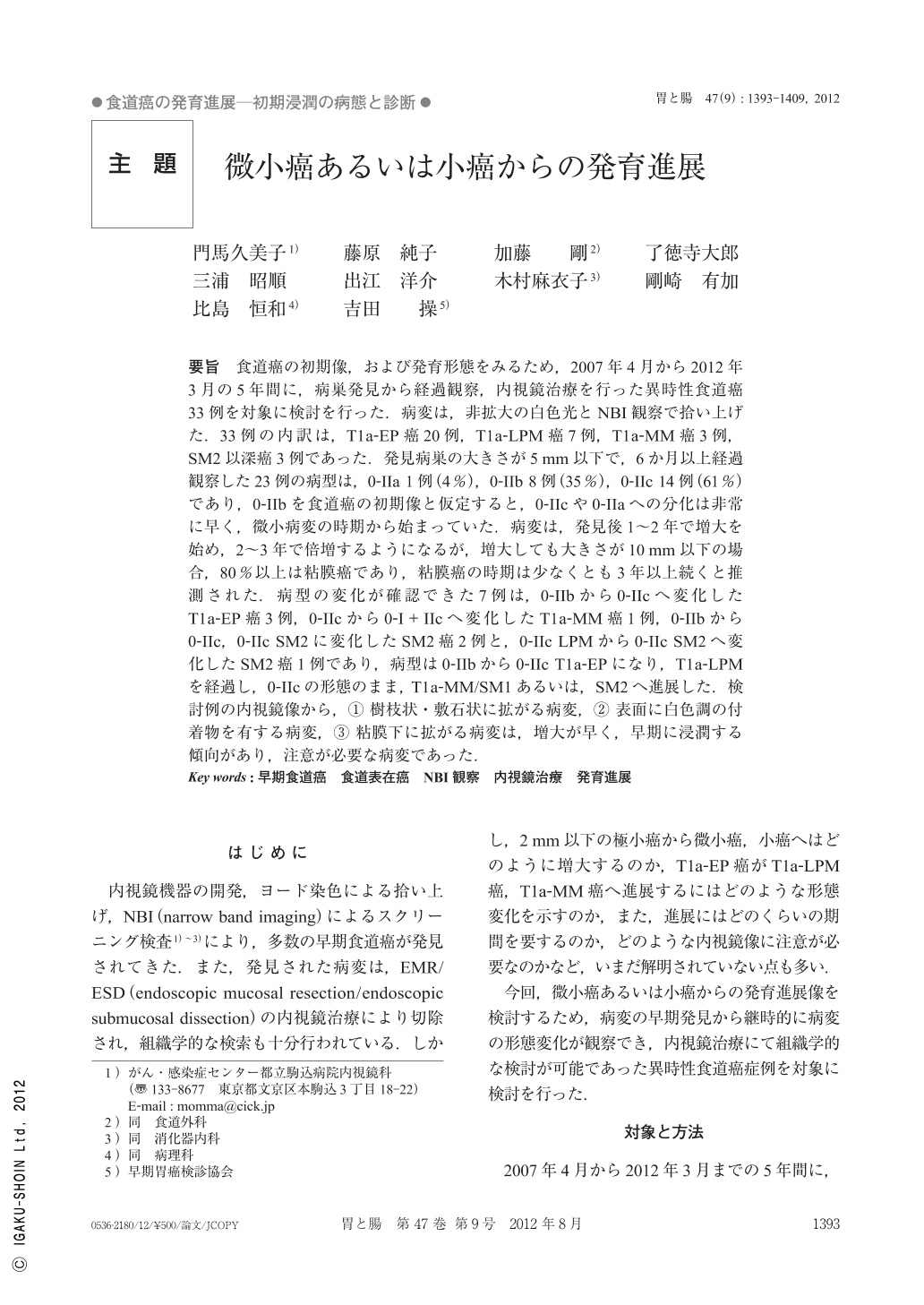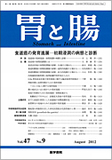Japanese
English
- 有料閲覧
- Abstract 文献概要
- 1ページ目 Look Inside
- 参考文献 Reference
- サイト内被引用 Cited by
要旨 食道癌の初期像,および発育形態をみるため,2007年4月から2012年3月の5年間に,病巣発見から経過観察,内視鏡治療を行った異時性食道癌33例を対象に検討を行った.病変は,非拡大の白色光とNBI観察で拾い上げた.33例の内訳は,T1a-EP癌20例,T1a-LPM癌7例,T1a-MM癌3例,SM2以深癌3例であった.発見病巣の大きさが5mm以下で,6か月以上経過観察した23例の病型は,0-IIa 1例(4%),0-IIb 8例(35%),0-IIc 14例(61%)であり,0-IIbを食道癌の初期像と仮定すると,0-IIcや0-IIaへの分化は非常に早く,微小病変の時期から始まっていた.病変は,発見後1~2年で増大を始め,2~3年で倍増するようになるが,増大しても大きさが10mm以下の場合,80%以上は粘膜癌であり,粘膜癌の時期は少なくとも3年以上続くと推測された.病型の変化が確認できた7例は,0-IIbから0-IIcへ変化したT1a-EP癌3例,0-IIcから0-I+IIcへ変化したT1a-MM癌1例,0-IIbから0-IIc,0-IIc SM2に変化したSM2癌2例と,0-IIc LPMから0-IIc SM2へ変化したSM2癌1例であり,病型は0-IIbから0-IIc T1a-EPになり,T1a-LPMを経過し,0-IIcの形態のまま, T1a-MM/SM1あるいは,SM2へ進展した.検討例の内視鏡像から,(1)樹枝状・敷石状に拡がる病変,(2)表面に白色調の付着物を有する病変,(3)粘膜下に拡がる病変は,増大が早く,早期に浸潤する傾向があり,注意が必要な病変であった.
We reviewed results of endoscopic follow up studies on 265patients who underwent endoscopic resection of superficial esophageal cancer from April 2007 to March 2012 and underwent repeated endoscopy after treatment. Thirty three cases developed metachronous esophageal cancer that had been treated by ESD(endoscopic submucosal dissection technique)after endoscopic follow up studies, and finally resected by ESD. Pathological studies had been carried out on the resected specimens. Final pathological diagnoses were squamous cell carcinoma of the esophagus(intraepithelial cancer : T1a-EP 20, cancer with invasion into the lamina propria mucosae : T1a-LPM 7, invasion reachin to the muscularis mucosae : T1a-MM 3 and invasion into the middle third the submucosa : SM2 3). Clinical and pathological results were studied to find macroscopic and histological characteristics of initial cancer lesion of the esophagus, and macroscopic changes in development. NBI(Narrow band imaging)observation and white light observation were employed for screening endoscopies.
〔Results〕In 23patients, metachronous cancers had been detected as minute cancer lesions less than 5mm in size. Endoscopic findings of them were type 0-IIa 1, 0-IIb 8 and 0-IIc 14. A small and type 0-IIb lesion has been believed as the initial lesion of the squamous cell carcinoma of the esophagus. The size of the initial lesion probably be very small considering the facts that endoscopic findings of the detected minute cancer lesions less than 5mm already included type 0-IIc(61%), 0-IIa(4%)and type 0-IIb(35%). Sizes of the cancer lesions started to increase one or two years after detection, and it took from two to three years to double. Depth of invasion remained within the mucosa while the size of the lesion was less than 10mm. Cancer lesions probably remain within the mucosa more than three years. Endoscopic findings changed in 7cases from type 0-IIb lesion changed into type 0-IIc EP(3cases), type 0-IIc into type 0-I+IIc MM(1), 0-IIb into 0-IIc SM2(2), and0-IIc LPM into 0-IIc SM2(1). Those facts strongly suggested that a squamous cell cancer of the esophagus starts as a small type 0-IIb lesion and it grow and frequently change into type 0-IIc EP, followed by invasion into the lamina propria mucosae(LPM)and finally into the submucosa(SM). Some endoscopic findings strongly suggested very rapid growth of cancer lesions : 1)a mucosal cancer with complicated shape such as branched border or multiple cancers scattered widely, 2)type 0-IIc lesion with partial and white coatings and 3)endoscopic findings suggesting sub epithelial or sub mucosal infiltration. They frequently invade into the submucosa in short time and treatment should be decided and carried out promptly.

Copyright © 2012, Igaku-Shoin Ltd. All rights reserved.


